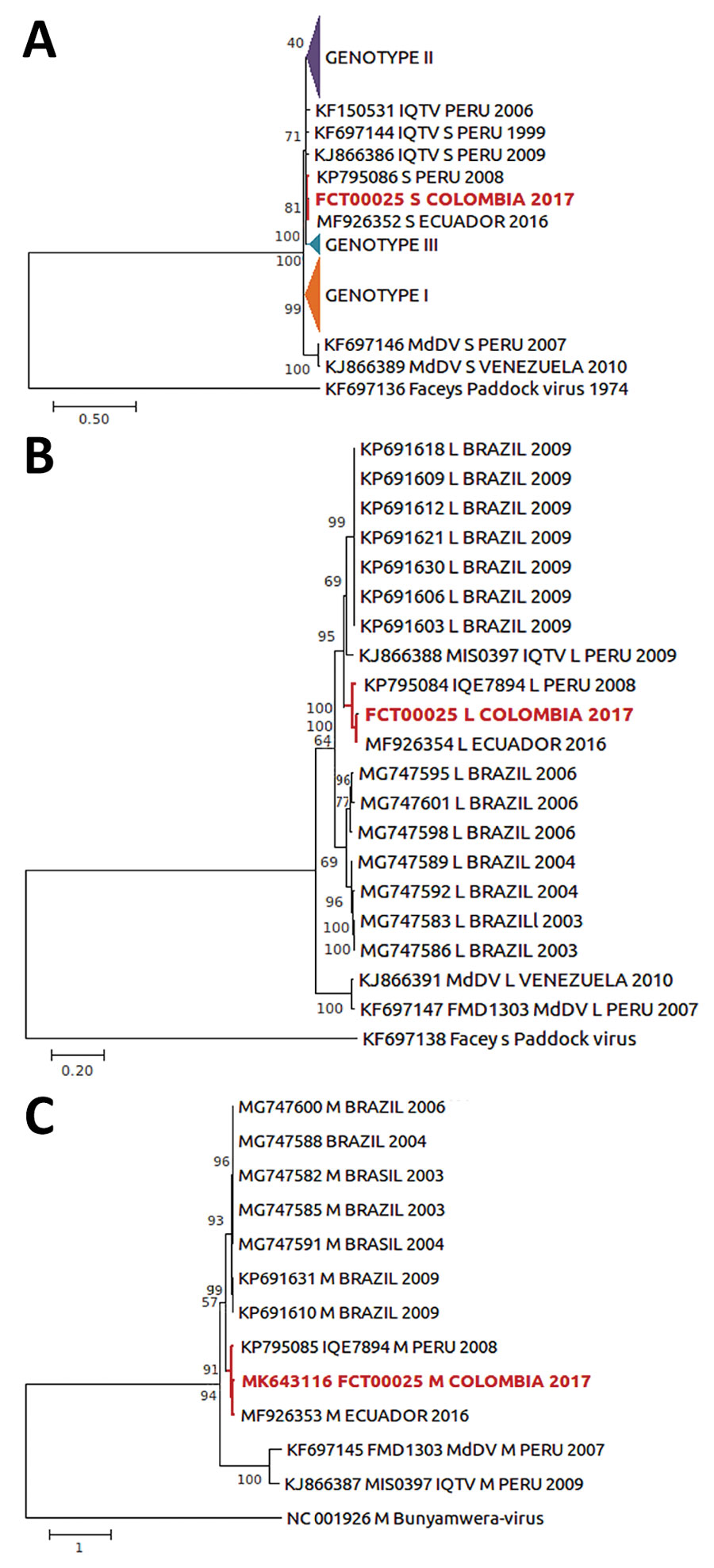Volume 27, Number 6—June 2021
Research Letter
Evidence of Oropouche Orthobunyavirus Infection, Colombia, 2017
Figure

Figure. Maximum-likelihood phylogenetic tree based on the small (A), large (B), and medium (C) segments of Oropouche orthobunyavirus from a patient in Colombia, 2017 (red text), and reference sequences. Numbers to the left of nodes indicate bootstrap values based on 1,000 replicates. GenBank accession numbers are given for representative strains used for comparison. Triangles indicate phylogenetic branches compressed for size (4,9). Faceys Paddock and Bunyamwera viruses were used as outgroups. Scale corresponds to phylogenetic distance units estimated by likelihood function model. IQTV, Iquitos virus; MdDV, Madre de Dios virus.
References
- Romero-Alvarez D, Escobar LE. Oropouche fever, an emergent disease from the Americas. Microbes Infect. 2018;20:135–46. DOIPubMedGoogle Scholar
- Wise EL, Pullan ST, Márquez S, Paz V, Mosquera JD, Zapata S, et al. Isolation of Oropouche virus from febrile patient, Ecuador. Emerg Infect Dis. 2018;24:935–7. DOIPubMedGoogle Scholar
- Sakkas H, Bozidis P, Franks A, Papadopoulou C. Oropouche fever: a review. Viruses. 2018;10:175. DOIPubMedGoogle Scholar
- Travassos da Rosa JF, de Souza WM, Pinheiro FP, Figueiredo ML, Cardoso JF, Acrani GO, et al. Oropouche virus: clinical, epidemiological, and molecular aspects of a neglected Orthobunyavirus. Am J Trop Med Hyg. 2017;96:1019–30.PubMedGoogle Scholar
- Groot Liévano H. Studies on arthropod-transmitted viruses in Colombia [in Spanish]. Revista de la Academia Colombiana de Ciencas Exactas, Físicas y Naturales. 2017;4:12–33.
- Hoyos-López R, Suaza-Vasco J, Rúa-Uribe G, Uribe S, Gallego-Gómez JC. Molecular detection of flaviviruses and alphaviruses in mosquitoes (Diptera: Culicidae) from coastal ecosystems in the Colombian Caribbean. Mem Inst Oswaldo Cruz. 2016;111:625–34. DOIPubMedGoogle Scholar
- Parra-Henao G, Suárez L. Mosquitoes (Diptera: Culiciadae) as potential vectors of arboviruses in the Urabá region, Northwest of Colombia [in Spanish]. Biomedica. 2012;32:252–62. DOIPubMedGoogle Scholar
- Forshey BM, Guevara C, Laguna-Torres VA, Cespedes M, Vargas J, Gianella A, et al.; NMRCD Febrile Surveillance Working Group. Arboviral etiologies of acute febrile illnesses in Western South America, 2000–2007. PLoS Negl Trop Dis. 2010;4:
e787 . DOIPubMedGoogle Scholar - Saeed MF, Wang H, Nunes M, Vasconcelos PFC, Weaver SC, Shope RE, et al. Nucleotide sequences and phylogeny of the nucleocapsid gene of Oropouche virus. J Gen Virol. 2000;81:743–8. DOIPubMedGoogle Scholar
- Djikeng A, Halpin R, Kuzmickas R, Depasse J, Feldblyum J, Sengamalay N, et al. Viral genome sequencing by random priming methods. BMC Genomics. 2008;9:5. DOIPubMedGoogle Scholar
Page created: March 25, 2021
Page updated: May 18, 2021
Page reviewed: May 18, 2021
The conclusions, findings, and opinions expressed by authors contributing to this journal do not necessarily reflect the official position of the U.S. Department of Health and Human Services, the Public Health Service, the Centers for Disease Control and Prevention, or the authors' affiliated institutions. Use of trade names is for identification only and does not imply endorsement by any of the groups named above.